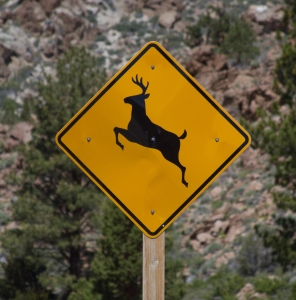 Department of Transportation District 9 Director Tom Hallenbeck cautions the traveling public to slow down and watch for deer. (press release)
Department of Transportation District 9 Director Tom Hallenbeck cautions the traveling public to slow down and watch for deer. (press release)
As the weather begins to rise in the high country, the deer population is moving to their summer feeding grounds. To reduce deer/vehicle accidents Caltrans identifies known deer migration crossings on State highways with warning signs. The vegetation along the sides of the roadway is mowed increasing the site distance of the driver. New construction and rehabilitation projects include flattening of the slopes next to the roadway and the removal of bitter brush seed from the re-vegetation mix. Biologist from Caltrans and Department of Fish & Game continue to study the habits of the deer population working to develop new technology that will improve driver safety as well as deer safety.
Ways to Prevent a Collision with a Deer:
Watch for the rest of the gang. Deer are pack animals, and rarely travel alone. If a deer crosses in front of you, chances are there are more nearby. Slow down and keep an eye out for more deer darting across the road.
- Timing is everything. Deer are most active at dusk and dawn: periods when your vision is most compromised. To add to their terrible timing, deer are on the move during mating season (between October and January) when you’re more likely to travel after the sun sets. Slow down and stay alert, especially after dark.
- Wear your seatbelt. It may not prevent a collision, but if the inevitable happens a seatbelt can reduce injuries. This is especially true if you lose control and collide with something bigger, and more stationary than a deer.
- Take a moment to reflect. First, look for the road signs. The yellow diamonds with the deer on it are placed in high-traffic areas for deer. You may also spot a deer because their eyes will brightly reflect a car’s headlights, making them easier to spot.
- Stay Center. On a multi-lane road, the center lane is your safest bet for avoiding a deer collision, as long as your local traffic laws permit it. This gives deer plenty of space; and in case your vehicle does startle them, it gives you more time to react if one darts onto the road.
- Stay the course. If you see a deer, brake firmly and calmly, and stay in your lane. Swerving could make you lose control of your vehicle and turn a bad situation much worse. Not to mention, deer are unpredictable, and you could swerve directly into their changed path.
- Honk! Some experts recommend that one long blast of the horn will scare deer out of the road. Do not rely on hood whistles or other devices designed to scare off deer — studies have shown them to be largely ineffective at minimizing accidents.
What to do if you hit a deer.
- Pull to the side of the road as soon as it is safe to do so.
- Turn on your hazard lights and remain in the vehicle until you are sure it is safe.
- Call emergency services if injuries are involved or the local police for property damage.
Stay away from the deer. If it is still alive, it could be confused, injured and dangerous if approached. When contacting the authorities, let them know if the deer is in a dangerous spot on the road so that it can be removed.

















couldn’t agree more. Inyo county has to have a major accident or fatality to spend the money on some signs…..just their way of showing respect for the “people”
…Many here are STILL waiting…..and wondering why….still no deer migration sign on Horseshoe Meadow road near the Tuttle Creek Campground turn-off in Lone Pine….in the years I’ve lived here,I need fingers on two hands….and toes on at least one foot….to count how many deer have been killed or maimed…and vehicles… Read more »